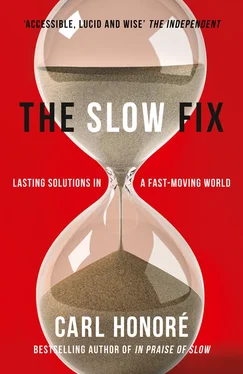par excellence . Feeling blue? Try Prozac. Struggling to concentrate? Join Team Ritalin. In the never-ending quest for instant relief the average Briton now pops, according to one estimate, 40,000 pills in a lifetime. I am certainly not the only impatient patient in Dr Woo’s waiting room. ‘The easiest way to make money today is not to heal people,’ he says. ‘It is to sell them the promise of instant healing.’
Indeed, spending money has become a quick fix in itself, with hitting the mall touted as the fastest way to lift sagging spirits. We joke about ‘retail therapy’ as we show off that new pair of Louboutins or the latest iPad case. The diet industry has turned the quick fix into an art form. ‘A bikini body by next week!’ the ads scream. ‘Lose 10 pounds … in ONLY 3 days!’
You can even buy a quick fix for your social life. If you need a workout partner at the gym, a best man for your wedding or a kindly uncle to cheer your children at sports day, or if you just want a shoulder to cry on, you can now hire any of the above from rent-a-friend agencies. The going rate for a pal to hang out with in London is £6.50 per hour.
Every quick fix whispers the same seductive promise of maximum return for minimum effort. Trouble is, that equation doesn’t add up. Think about it for a moment: is worshipping at the altar of the quick fix making us happier, healthier and more productive? Is it helping to tackle the epic challenges confronting humanity at the start of the 21st century? Is there really an app for everything? Of course not. Trying to solve problems in a hurry, sticking on a plaster when surgery is needed, might deliver temporary reprieve – but usually at the price of storing up worse trouble for later. The hard, unpalatable truth is that the quick fix never truly fixes anything at all. And sometimes it just makes things worse.
The evidence is all around us. Even as we drop billions of pounds on diet products promising Hollywood thighs and Men’s Health abs in time for summer, waistlines are ballooning all over the world. Why? Because there is no such thing as One Tip to a Flat Stomach. Academic studies show that most people who lose weight on diets regain it all, and often more, within five years. Even liposuction, the nuclear option in the slimming arms race, can backfire. Fat sucked from a woman’s thighs and abdomen usually resurfaces within a year elsewhere on her body, as bingo wings, say, or shoulder flab.
Sometimes, the quick fix can be worse than no fix at all. Look at ‘retail therapy’. Buying the latest Louis Vuitton bag may lift your mood, but the effect is usually transient. Before long you’re back online or in the mall hunting for the next thrill – while unopened bills pile up like snowdrifts by the front door.
Look at the damage wrought by our penchant for pills. Surveys suggest that nearly two million Americans now abuse prescription drugs, with more than a million hospitalised every year by the side effects of medication. Overdosing on legal pills is now a leading cause of accidental death in the US, where the black market in hard-to-get medication has fuelled a sharp rise in armed robberies at pharmacies. Even neonatal units are reporting a spike in the number of babies born to mothers with painkiller addictions. And it’s not a pretty sight: newborns suffering from withdrawal scream, spasm and vomit, rub their noses raw and struggle to eat and breathe.
You certainly cannot solve hard problems by just throwing money at them. To mend its ailing public schools, New York City began linking teacher pay to pupil performance in 2008. After forking out more than $55 million over three years, officials scrapped the programme because it was making no difference to test scores or teaching methods. It turns out that fixing a floundering school, as we will see later in the book, is a lot more complicated than just doling out cash bonuses.
Even in business, where speed is usually an advantage, our fondness for the quick fix is backfiring badly. When firms hit choppy waters, or come under pressure to goose the bottom line or jack up a sagging stock price, the knee-jerk response is often to downsize. But shedding staff in a hurry seldom pays off. It can hollow out a company, demoralise the remaining workforce and spook customers and suppliers. Often it leaves deeper problems untouched. After sifting through 30 years’ worth of longitudinal and cross-sectional studies, Franco Gandolfi, a professor of management, came to a stark conclusion: ‘The overall picture of the financial effects of downsizing is negative.’
The rise and fall of Toyota is a cautionary tale. The Japanese car-maker conquered the world by obsessively tackling problems at their source. When something went wrong on the assembly line, even the lowliest worker could pull a cord, known as the Andon rope, which would cause a buzzer to ring and a light bulb to flash overhead (‘andon’ means ‘paper lantern’ in Japanese). Like a toddler, staff would ask ‘Why, why, why?’ over and over again, until they reached the root cause of the problem. If it turned out to be serious, they might stop the entire production line. In every case, they would devise a permanent solution.
But everything changed when Toyota embarked on a headlong dash to become the number one car-maker in the world. Management overreached, lost control of the supply chain and ignored warnings from the factory floor. They started putting out fires without asking why those fires were breaking out in the first place.
Result: a recall of more than 10 million faulty vehicles that shredded the firm’s reputation, wiped out billions of dollars in revenue and unleashed a barrage of lawsuits. In 2010 Akio Toyoda, the company’s chastened president, explained to the US Congress how Toyota fell from grace: ‘We pursued growth over the speed at which we were able to develop our people and our organisation.’ Translation: we stopped pulling the Andon rope and fell for the quick fix.
You see the same folly in professional sports. When a team hits a slump, and the clamour for a turnaround reaches fever pitch in the stands and the media, owners reach for the oldest fix in the playbook: fire the coach and hire a new one. As the world has grown more impatient, the scramble for results on the field has turned more frantic. Since 1992 the average tenure of a manager in professional football in England has fallen from 3.5 years to 1.5 years. In the lower leagues six months to a year is now the norm. Yet turning management into a revolving door is a bad way to run a team. Academic research shows that most new managers deliver no more than a short honeymoon period of better results. After a dozen games the team’s performance is usually the same, or worse, than it was before the regime change. Just like a weight-watcher piling the pounds back on after a crash diet.
You see the same mistakes in war and diplomacy. The US-led coalition failed to back up the shock-and-awe invasion of Iraq in 2003 with proper long-term plans for rebuilding the country. As Western troops amassed on the border, Donald Rumsfeld, then the US Secretary of Defense, put a modern spin on the old chestnut that the soldiers would be ‘home for Christmas’. The war in Iraq, he declared, ‘could last six days, six weeks. I doubt six months.’ What followed was years of chaos, carnage and insurgency, capped by an ignoble retreat from a job half done. In the salty argot of the US military, the brass ignored the golden rule of the seven Ps: Prior Planning and Preparation Prevents Piss-Poor Performance.
Even the technology industry, that great engine of speed, is learning that you cannot solve every problem by simply crunching more data and writing better algorithms. A team of IT specialists recently rode into the World Health Organisation headquarters in Geneva on a mission to eradicate tropical diseases such as malaria and Guinea worm. A culture clash ensued. The Tropical Diseases department is a million miles from the hip working spaces of Silicon Valley. Grey filing cabinets and in-trays piled high with folders line a dimly lit corridor. A yellow, hand-written note saying ‘Hors Service’ (out of order) is taped to the coin slot of the drinks machine. Sandal-wearing academic types work quietly in offices with tropical fans on the ceiling. It feels like the sociology department of an underfunded university, or a bureaucratic outpost in the developing world. Like many of the experts here, Pierre Boucher was stunned and amused by the can-do swagger of the IT interlopers. ‘These tech guys arrived with their laptops and said, “Give us the data and the maps and we’ll fix this for you,” and I just thought, “Will you now?”’ he says, with a wry smile. ‘Tropical diseases are an immensely complex problem that you can never just solve on a keyboard.’
Читать дальше












